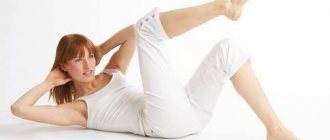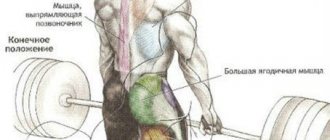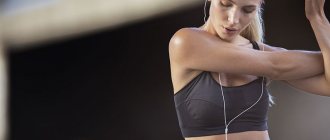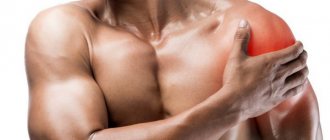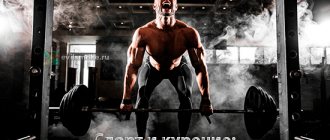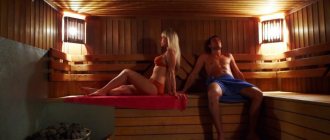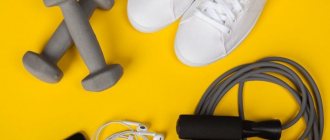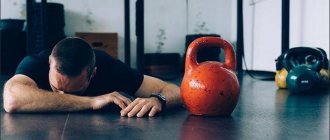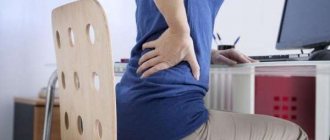Methods for relieving muscle pain
On average, it takes 48 hours for scarring, complete healing and fiber restoration to occur. It is recommended to do the following:
- do a soft tissue massage; hydromassage should be avoided;
- take a warm bath with sea salt or essential oils for 15 minutes;
- resort to physical exercise;
- take advantage of bathing procedures in the form of a visit to the Finnish sauna;
- ensure sufficient sleep time, since recovery processes occur during the period of muscle rest;
- provide the body with a sufficient amount of “building” materials in the form of proteins, carbohydrates, vitamins and minerals;
- arrange a bath procedure.
The most popular for pain relief is the use of Voltaren or Emulgel with a dosage of active ingredients in an amount of 1%. Even if the muscles hurt badly, sports experts do not recommend resorting to taking pharmacological drugs. In case of increased body temperature and severe symptoms of overexertion, you can take Ibuklin in accordance with the dosage indicated in the instructions for the drug. The drug has anti-inflammatory, analgesic, antipyretic effects and belongs to the category of non-steroidal drugs. It is recommended to resort to ointments and medications only in extreme cases.
The last recommendation, in the form of the need for physical activity when muscles hurt, often causes a little surprise among novice athletes. In fact, performing a set of exercises allows you to increase blood flow in sore areas and promotes better nutrition of inflamed tissues, as a result of which the healing process is faster. This recommendation should not be used for several hours after training, since the muscles need time for basic recovery.
You should not use exercises with serious power load; to relieve pain symptoms, it is enough to perform a set of warm-up exercises. Anaerobic exercise is considered to be the most effective for removing lactic acid, so it is recommended to jog at a slow pace for 5-10 minutes, after which it is recommended to do stretching exercises.
Why do muscles hurt after training?
Pain is a reflection of the process during which muscle structures are destroyed. According to a study conducted by Sterlig and Morozov, physical exercise displaces the myofibrils of muscle fibers, mitochondria disintegrate, which provokes an increase in the level of white blood cells in the blood. A similar condition occurs with injuries, inflammation, and infections.
As a result of the destruction of muscle tissue fibers, protein fragments of molecules are formed, and cells that digest damaged tissue, called phagocytes and lysosomes, are activated. They secrete products that cause pain. Muscle fibers, when destroyed, form satellites, which are cells that provoke the production of protein by tissues.
There is another fact that does not raise any doubts, which is that pain during bodybuilding is felt especially acutely only after the first workouts, and then, when they become regular, they are almost no longer felt. If there is a long pause in classes, they appear again.
When training is completed, protein production in the body accelerates, which leads to the accumulation of creatine phosphate in muscle tissue, increasing the level and activating glycolytic enzymes. This process becomes much more efficient over time, and therefore oxidation occurs, which is the source of energy for muscle contractions. The amount of training you do makes it almost impossible for your muscles to deplete their energy source.
Thanks to regular training, the energy potential for the muscles increases, and, consequently, performance indicators with strength. On the other hand, there is a reduction in applied stress and training impact. The reverse reaction is that muscle adaptation slows down. This phenomenon is called a training plateau, when in order to make a breakthrough it is necessary to change the load and training factors, changing splits, rest time between sets, exercises performed using supersets, drops, and so on.
httpv://www.youtube.com/watch?v=embed/5mM3Bntq7Q0
My hands go numb - why?
Numbness is a very common symptom after exercise, but the consequences can be very unpleasant.
If your arms were suspended long enough during the exercises, you could cause blood to flow out, which led to a lack of sensitivity. As a rule, the hands and forearms become numb first. Another possible cause is a disruption in the transmission of nerve impulses from the brain to other organs. May appear with a deficiency of B vitamins.
Pinched nerves and compression of blood vessels. Possibly with osteochondrosis
If you have this disease, your training program should be drawn up based on your doctor’s recommendations, otherwise, if you handle your body carelessly, you may unknowingly destroy nerve fibers.
Tunnel syndrome or carpal tunnel syndrome. Happens to those who work a lot at the computer
It manifests itself as numbness and immobility of the fingers or the entire hand. If not both arms are numb, but only the left one, this may indicate one of the cardiac diseases. In such a situation, you should stop training and consult a doctor as soon as possible.
Pain after training
Have you been trying to heal your JOINTS for many years?
Head of the Institute for the Treatment of Joints: “You will be amazed at how easy it is to cure your joints by taking the product every day for 147 rubles...
Explanations for why arm muscles hurt after training should be sought in the peculiarities of the human body. The main cause of muscle soreness is the formation of lactic acid, which is formed as a result of the breakdown of glucose occurring in the tissues. Such chemical reactions begin to occur in tissues during intense training, when muscle fibers require additional energy to perform exercises and receive it by breaking down glucose.
In some cases, a person may experience trembling. Discomfort in the arm muscles may continue for several hours. Due to the anatomical features of the body, in order to quickly get rid of pain in the arm muscles, it is necessary to increase blood circulation immediately after training.
What to do if your arm muscles hurt after training:
- do sets of stretching exercises;
- take a shower with warm water;
- resort to massage;
- drink a couple of glasses of warm water.
After following the above recommendations, lactic acid will be eliminated faster and the pain will go away.
httpv://www.youtube.com/watch?v=embed/CtJ8ZCdIbHc
Let's name the main reasons why many people gain weight after training:
Muscle swelling
A common reason why body weight increases after exercise. During the first month after intense exercise on the muscles, water accumulates in them. As a result, the muscles increase their volume, and the person gains weight. Sometimes people mistakenly associate this phenomenon with muscle growth. Due to the natural characteristics of physiology, it is difficult for women to gain even a kilogram of muscle. Athletes who can boast of pumped up biceps, as a rule, use male hormones and use drugs aimed at accelerating muscle growth. As a result, the hormonal background changes towards the male one, so you should not hope that in three sessions the muscles will grow by 1 kg. During standard training, almost no muscle growth occurs, so this is another cause for concern. The maximum you will achieve is muscle tone and a sculpted body.
Human weight is a complex of the mass of all components of the body:
- Muscle
- Bones
- Fats
- Brain
- Nerve fibers
- Various fabrics
- Blood
- Air
After standard training, the ratio of all these components changes by approximately 15%. And intense training greatly influences the variability of the indicator on the scale. Body weight changes depending on muscle inflammation and soreness, which occurs immediately after the first visits to the gym.
How to deal with this?
Since this is a natural process that occurs in the body, nothing can be done about it. Give your muscles a few weeks to adapt and recover, and you will notice that the weight will begin to decrease. In this case, the most important thing is not to be afraid of the scales and continue to exercise.
If calorie content exceeds diet
Sometimes the cause of initial weight gain is compensatory nutrition. As a rule, on average, training allows you to burn up to 500 kcal. And this is just a small piece of cake or pastry. If you eat more than your body is able to absorb, this will not by itself give you the opportunity to get rid of extra pounds. Even intense training will be powerless.
Pathological factors
It may be painful to straighten your arm at the elbow after training due to diseases of the spine and joints:
- Osteochondrosis of the cervical and thoracic spine. Although mobility in the elbow is preserved, it is very painful to straighten and bend the arm.
- Epicondylitis of the elbow joint. This is an inflammatory process of the tendons after intense physical exertion. It manifests itself as pain in the elbow during grasping, rotational movements, or lifting a load. External changes are not visible, however, pain occurs on palpation.
- Arthrosis can be a consequence of a past injury or hormonal imbalances in the body. Pain occurs during flexion-extension movements, sometimes accompanied by a crunching sound. If treatment is not started in time, bone growths will form on the bone, which can subsequently lead to the fact that the elbow will no longer fully extend.
- Arthritic inflammation of the joints can lead to the arm not straightening at the elbow after training. The painful area swells and the skin color changes.
5. Bursitis can develop as a result of arthritis. Swelling appears on the back of the elbow from the accumulation of fluid in the synovial bursa of the olecranon.
Swelling of the calf muscles
Swelling and pain in the calf muscle is a symptom that many have encountered. It causes discomfort, accompanied by heaviness and pain. Sometimes the swelling in the calf muscles is minor and almost unnoticeable, but this is also an abnormal condition that needs to be given due attention.
- Bruised tailbone: symptoms and treatment
- Interpretation of ECG indicators
There are several reasons for the appearance of swelling of the legs, causing mild or severe pain:
- phlebeurysm;
- injuries;
- excessive stress on the legs;
- cardiovascular disorders;
- kidney and liver diseases;
- wearing uncomfortable and tight shoes.
In these cases, eliminating the original cause that caused the problem allows you to get rid of pain in the legs and remove swelling.
Universal training tips
When planning to improve your physical fitness by starting exercises and training, it is better not to take them lightly. Most often, with correctly calculated loads, it is possible to achieve your goals quite quickly. If you can’t make the right plan yourself, you can turn to a professional trainer. For a beginner, this is simply a must, so as not to end up with the problems described above.
There are a number of simple tips that you can follow when working out in the gym or at home. This will protect you from risks and give you a chance to quickly achieve results.
Graduality is the key to success
Only by slowly increasing the load can you go all the way from start to finish without problems. On the third day, you shouldn’t strive to do everything like the pumped-up men who have been visiting this place for many years. Start small, otherwise health problems cannot be avoided.
Good warm-up and cool-down
Any workout begins with a good warm-up and ends with a cool-down; this is an immutable law. Only with this approach will you avoid injuries to muscles, ligaments and joints. At the same time, make sure that your warm-ups work exactly the muscles that you will train. Stretching exercises or light jogging are ideal as a cool-down.
Technology is everything to us
Never start an exercise unless you know exactly how to do it. Especially when it comes to complex exercise equipment that you don’t fully understand. Mistakes and missteps can do more than just cause you to fail to make progress. You can get seriously injured, from which you will have to recover for a long time.
Drink plenty of fluids
If you drink little, especially when doing workouts, your blood will become somewhat thicker. This creates additional stress on the heart and blood vessels. Therefore, you need to drink as much as your body requires. There is a lot of material on how and when to drink water during training, which would not hurt to read separately.
Water treatments
If we carefully consider almost all the problems that we have discussed, an interesting fact emerges. A swimming pool and a contrast shower are great for solving almost all of them. It wouldn’t hurt to carry out water procedures of this kind regularly, as they have a general healing effect.
Proper nutrition
Don't forget that the diet should be balanced. This is especially true for those who train hard. If the body does not receive enough of the vitamins and minerals it needs, then it will be much more difficult for the muscles to bear the load. Moreover, improperly organized nutrition can lead to serious complications and the development of diseases.
Relaxing massage
If during training you have any problems with your hands (increased sensitivity, pain, swelling, etc.), a relaxing massage will help
But even those who are fine and have no unpleasant symptoms should pay attention to it. It benefits both professional athletes and green beginners in the gym.
Pain relief with medications
In the most extreme case, when there is no strength to endure the pain, many use painkillers. However, this can only be done according to a doctor’s indications and nothing else. Thoughtless, uncontrolled absorption of medications that you “prescribed” for yourself leads to disastrous consequences. Although for mild symptoms it is quite acceptable to use soothing, relaxing or cooling creams and ointments.
Character of tumors
Tumors that can be found on muscles are of a different nature - benign and malignant. Benign ones include leiomyoma and rhabdomyoma.
Leiomyoma is localized on smooth muscle, regardless of age. If treatment is not taken, the tumor can turn malignant. The swelling develops slowly and manifests itself as ulcers on the surface of the skin. Rhabdomyoma is localized primarily on the transversely striated muscles of the chest, back, arms and legs, as well as in the neck.
Malignant muscle tumors are dangerous, so they cannot be avoided without medical help. One of the varieties is rhabdomyosarcoma, which develops similarly to rhabdomyoma, but is of a low-quality nature. Most often, pathologies develop in the thighs and calf muscles of adults.
Less common is malignant leiomyosarcoma, which affects smooth muscle, mainly in women. Localized on the trunk and lower extremities, accompanied by ulcers on the surface of the skin. One of the most dangerous muscle tumors is osteoclastoma, which requires urgent surgical intervention.
Be attentive to your body and do not allow tumors to develop. If your muscles swell frequently, be sure to see a doctor and get a diagnostic test to avoid serious health problems in the future.
Muscle pain the day after training
Late or delayed muscle pain appears a day after training.
If everything is now clear about the burning sensation in the muscles at the end of a workout, then for many of us it remains a mystery why the muscles hurt the day after a workout. Delayed or, as it is also called, delayed pain appears a day after the end of the training. On the second day, as a rule, it intensifies, and then gradually fades away.
This pain is much more unpleasant and painful than post-workout pain. It prevents you from moving and discourages any desire to go to training again.
The cause of such pain is no longer lactic acid in the muscles, but microtrauma of the muscle fibers that form when performing high-load exercises. Tiny micro-tears form in muscle fibers that contract under load. They do not cause us discomfort immediately after training, but after a day they begin to become inflamed and then pain appears.
There is no need to be afraid of this inflammation; it is aseptic (without germs) and is caused by the reaction of muscle tissue to overstrain. After a few more days, the inflammation subsides and the damaged tissue scars. The muscle increases in volume accordingly.
In order to reduce the pain symptom in case of delayed pain, you can use anti-inflammatory ointments - they are sold at any pharmacy. A small massage will also be beneficial - gently stretch the muscles, but without strong impact.
Oddly enough, physical activity will help speed up muscle healing. Exercise improves blood flow and speeds up metabolism, and, accordingly, muscles recover faster. However, it’s worth making a reservation here that the load should not be extreme and not on the very next day. Give yourself a little time to get in shape. And to the question of what to do if your muscles hurt a lot after training, the best answer is - give your body a little rest. Otherwise, you risk overtraining.
Back and neck muscles
The muscles of the back, lower back and neck can swell and ache not only after training, but also for other reasons. For example, people who work outdoors all year round are at risk. Common reasons include staying in uncomfortable positions for a long time, which often happens to drivers, musicians, and massage therapists. This leads to poor circulation and poor nutrition of muscle tissue. Seals appear and dystrophy develops. Other causes of swelling in the muscles of the neck, back or lower back include:
- injuries during training (most often sprains or physical strain);
- injuries in everyday life: bruises, dislocations of the vertebrae;
- stress causing muscle spasms;
- hypothermia during physical exertion.
In the neck area, the most vulnerable muscle is the cleidomastoid muscle, which is quite easy to pull.
In rare cases, people experience pain and swelling in the muscles in their feet, shoulders, or armpits. If the problem is not intense training, that is, the swelling does not subside within a day, you need to go to see a doctor. He will determine why the muscles are swollen and prescribe the necessary treatment.
First aid for a torn ligament
If after training you find that there is sharp pain in your elbow, swelling, a bruise, it is impossible to move your arm and elbow, and deformation of the elbow joint is visually visible, then most likely you have a ligament rupture. The first step is to apply cold to the sore spot, for example, ice wrapped in a napkin, and immobilize the arm by fixing it with a splint.
You can do a light massage around the elbow, but only where there is no pain. This will speed up blood flow and reduce pain. You should absolutely not take a hot shower or heat the rupture site. After a couple of days, when the pain subsides and the swelling subsides, you can apply warm compresses and begin working out your arm with smooth movements.
If it was not possible to cope with the problem at home, and the pain and swelling, on the contrary, only increase, you need to consult a doctor.
Is it normal for your hands to shake after training?
Many, even experienced athletes, have trembling hands after training. The reasons are quite simple and easy to fix.
Lack of energy
Tremor usually occurs from weakness when the muscles are not in good shape.
- Sleeping poorly at night, and going to training in the morning is a bad idea, because the body has not had time to rest and recover. You simply do not have enough strength to perform the exercises, and any load will be excessive for the muscles.
- If the day before you were very nervous for some reason and clearly spent a lot of energy, then it’s also not worth forcing your body to work beyond normal and give up the remaining strength.
- The same applies to the situation when you are overtired at work, and training is next on the schedule. There is no need to waste the rest of the energy that will be used to restore the body after a hard day, advises hudeem-bez-problem.ru.
- Another reason why trembling hands may appear is an incorrectly calculated training program. Your body may not be ready for excessively heavy physical activity. Herbal preparations such as valerian, as well as rest and relaxation, will help the body restore wasted resources.
Lack of useful and nutritious substances
An unbalanced diet, as a result of which your body lacks vitamins and minerals, can also cause trembling in the hands after physical activity.
The load should be selected by a qualified trainer
If you are not able to independently create a diet for yourself that will include all the important components - proteins, fats, carbohydrates, minerals, macro and microelements, seek help from a nutritionist who works with athletes.
It is quite possible that all the important elements do not have time to enter the blood in the required quantities, and then the doctor can help.
Questions and answers why weight increases after exercise
1. I started exercising regularly to lose weight, but after 3 weeks the weight did not decrease at all. Does this mean I'm not losing weight?
During physical activity, muscles retain water, so the weight may increase or stay the same as a result of training, while the fat layer will disappear. Try to measure volumes and look at changes in body quality (take photographs), this is a much more visual way to monitor the process of losing weight.
2. I've been training for a month now, but the weight is increasing. I measure the volumes, look at the “before and after” photos - almost no changes. What could be wrong?
To lose weight, it’s not enough to just exercise; you need to watch your diet. As we already said, 80% of success in losing weight depends on nutrition. Exercise helps to tighten the body, improve its tone, get rid of sagging, but the process of losing weight and getting rid of excess fat is possible only with a calorie deficit. If you are not losing weight (regardless of whether you exercise or not), then you need to reconsider your diet.
3. I try to eat right and exercise for a long time, but the weight does not decrease. Why?
The main law of weight loss: eat less than the body is able to expend energy during the day, so that fat reserves begin to be consumed. All diets or nutrition systems are based on this. One of the most convenient and effective methods of controlling food for weight loss is counting calories. In this case, you will not be limited in the range of products and will be able to plan your menu yourself during the day: the main thing is to keep within the given numbers, i.e. eat in a calorie deficit.
Just because you're eating healthy doesn't mean you're eating in a calorie deficit. Even with healthy products, you can go over your acceptable limit. In addition, very often during sports activity the appetite increases, thus the body tries to replenish the energy spent. Therefore, you may, without noticing it, start eating more: snacking more often, eating larger portions, choosing higher-calorie foods. Without control and clear numbers, we cannot always correctly formulate a menu for weight loss.
What is contraindicated to do if there is pain?
There are a number of symptoms that signal to us that the body is not ready for training. In such cases, it is better to give them a rest and then return to the exercises with renewed vigor.
- Feeling very tired.
- Respiratory and infectious diseases.
- Exacerbation of chronic diseases.
- Increased body temperature.
Neglecting the rules of exercise or exercising with the symptoms described above means harming yourself. If the unpleasant sensations do not go away for several days, and no folk advice helps, then it will not hurt to consult a doctor. Only a doctor can determine exactly what is happening in your body and why your arms hurt after training.
httpv://www.youtube.com/watch?v=embed/GklQIwUUWqc
httpv://www.youtube.com/watch?v=embed/plbGf0Ab94w
Swelling of the legs
Edema is considered to be a consequence of the accumulation of lymphatic fluid in various parts of the body. Edema is considered the result of an imbalance in the body's tissues and venous vessels, from which excess fluid is released.
Edema is often caused by various types of diseases. Sometimes it happens that a person is healthy, but swelling is present. Swelling often appears after active sports. It is not clear why my legs swell after exercise.
Often the location of edema can tell about the cause of the lesion. Accurate information on the occurrence and further control is provided by a competent doctor.
Leg problems after exercise
Take good care of your knees
Even if your knee joints are not bothering you at all yet, you need to take preventive measures to prevent this from happening for as long as possible. Even if your knees simply crunch a lot after training when bending, this is already a reason to think about it. And if they are already sick, then even more so.
For prevention, you should load yourself gradually, without jerks, taking into account the level of physical fitness and state of health, the “second wind” of beginners is not a reason to overload.
Do not forget about medical examinations if the same uncomfortable conditions are repeated and about proper nutrition. Eat foods high in minerals and vitamins, because with sweat the salts, microelements and water necessary for joints are removed from the body. Lots of fruits and vegetables, meat, fish and dairy products, as well as 1.5-2 liters of water per day - and your knees will thank you for a long and trouble-free service.
Pain due to injury
This type of pain is the most dangerous and requires immediate action. Painful sensations from arm muscle injuries have characteristic symptoms, so a person understands the occurrence of a problem almost immediately. They are characterized by the following features:
- sudden onset of pain;
- localization of a point nature;
- discomfort that does not go away for a long time;
- inability to continue training;
- external changes in the injured area, in the form of swelling, the appearance of an uncharacteristic skin tone, and an increase in its temperature.
Pain from injuries can be intermittent and only appear when the athlete tries to do certain types of exercise. If such signs appear, it is recommended to immediately seek medical help. Experts do not advise delaying visiting a doctor and doing this even if there is a suspicion of an injury to the arm muscles.
Universal tips when playing sports
A gradual increase in loads is the right approach that you need to pay attention to;
Mastering the correct technique for performing each exercise. There are no small things in this! An incorrectly performed exercise can lead not only to muscle pain, but also to serious injury;
Mandatory special warm-up before starting training
Exercises should be aimed at the muscle groups that you will use in the workout. This will warm up the muscles, improve blood supply and prepare the ligamentous apparatus for stress;
Contraindications for training are fatigue, poor health, and respiratory diseases. This is a signal: the body needs rest;
Drink enough water. Thick blood creates an increased load on the heart, since it is not easy to pump through the vessels;
Getting enough sleep will ensure your body recovers well after training. According to instructors, muscle pain can be caused by the fact that a person does not get enough sleep and the muscles do not receive complete relaxation;
When you start training, please take it seriously. If the loads are calculated correctly, then you will be able to achieve the results you dreamed of.
By neglecting the rules and advice of the instructor, instead of the desired results - a slim figure and defined muscles, you can harm your health. Systematically attending workouts without breaks will help your body get used to the stress. It will give you muscle joy and minimize pain. Use our tips and recommendations and be healthy, cheerful and joyful!
Nowadays it has become fashionable to lead a healthy lifestyle. Therefore, many men and women begin to eat right and also exercise to the best of their ability. However, without practical experience, it suddenly turns out that many nuances remain unclear. For example, the question of what to do if your arms hurt after training worries many beginners, and not only athletes. Let's look at the question together and finally give an answer to what is happening to our body and why such negative moments can be observed.
Why do muscles swell after exercise and what to do about it?
Nowadays it has become fashionable to lead a healthy lifestyle.
Therefore, many men and women begin to eat right and also exercise to the best of their ability. However, without practical experience, it suddenly turns out that many nuances remain unclear. For example, the question of what to do if your arms hurt after training worries many beginners, and not only athletes. Unpleasant symptoms in the arm muscles usually arise for a reason. Most often this happens due to excessive overvoltage, incorrectly calculated, unbalanced load. Sometimes this phenomenon can be observed in athletes who have not had the opportunity to train for a long time.
With the right approach, a well-constructed plan and a suitable sports program, unpleasant symptoms should not appear after training. You should feel pleasantly relaxed and slightly tired. However, before you start doing any exercises, do not forget to warm up. This will give the muscles, ligaments and joints a chance before loading.
If a person has never played sports before, then muscle pain may well occur. But soon, after the second or third training, it disappears by itself, leaving behind only a memory. The body gradually adapts to the load, so the discomfort disappears on its own. However, sometimes pain can return for various reasons, which we will consider in our article.
Muscle swelling after strength training is a fairly common phenomenon. The reason may not only be in the training itself - sometimes it is a signal from the body about problems. In what cases is swelling normal, and when is a doctor’s help needed? What to do to remove swelling?
There are several reasons why muscles may swell after exercise. They can be divided into two groups: disease-related and non-disease-related.
In this case, the swelling will differ:
- for reasons not related to internal diseases, spasm and swelling of the muscles are characteristic, hard to the touch, as if in constant tension;
- a sign of the disease will be the accumulation of fluid in the intercellular space - in this case, the muscles feel soft to the touch.
Muscle pain is familiar to all athletes, from amateurs to top-class professionals. However, this does not mean that every activity should be accompanied by the inability to get out of bed the next day. There are legends about highly qualified instructors, after classes with whom the muscles almost do not hurt, while the figure clearly becomes better. Do your muscles hurt after training? Then read on.
There is a popular belief that the cause of muscle pain is the accumulation of lactic acid in them. In fact, the reason is different: when overloaded, muscle fibers are damaged. After which, provided proper nutrition and rest, muscles recover after training and even their relative increase.
They also become more defined by consuming large amounts of carbohydrates, as bodybuilders who are preparing to demonstrate their performance in competitions know. And after training, the muscles may swell a little and increase in volume. By the way, this often gives a plus on the scales, but don’t worry, 48 hours and the excess water will go away on its own. The main thing is not to start overeating on fatty and sweet foods out of grief, otherwise the plus will only increase.
Although some discomfort is normal, in some cases, when your muscles are sore after exercise, you should consult a doctor. Firstly, if the pain does not end when you stop moving. Secondly, if the pain that occurs can be called acute. Thirdly, if severe pain does not go away after 72 hours.
Most often, muscles ache after training among gym goers, although some aerobics instructors are able to bring the muscles to a damaged state. The main thing is not to be scared, but to be happy, since without damage there will be no improvement in the relief. You need to increase the load over time, maybe in leaps and bounds.
Work out at one intensity for a week, get used to it, and then the next week increase the load. Your muscles will certainly ache, but you will know that they are getting stronger. And gaining muscle mass will mean you can eat more calories without the risk of gaining fat mass. However, additional calories should be obtained primarily in the form of protein, to some extent carbohydrates, but not from fat.
The exception is fatty fish; you can eat it even if you are losing weight. Proteins will help your muscles rebuild faster; they can be consumed 40 minutes after training, when the muscles are ready to take maximum nutrients from the blood. If your goal is muscle growth, do not disdain slow carbohydrates: buckwheat, oatmeal, dark rice. This will allow the muscles not to devour themselves, but to use the resulting proteins to build tissue.
It is necessary to give your muscles a rest period of at least 36 hours; continuous training will only cause resource depletion. Do not overdo it.
Do muscle relaxation exercises help? Yes, and these do not necessarily have to be stretching exercises, contrary to popular belief. However, they must be accompanied by an increased supply of oxygen to the muscles. You don't need to breathe too deeply to do this; in fact, deep breathing often paradoxically causes oxygen deficiency.
The best way to provide plenty of oxygen is to increase your breathing rate through physical activity. After aerobics, you don’t need to do special exercises; you’ll already be feverishly gasping for air. But after sports such as Pilates or callanetics, you need to give yourself a more intense load before you actually start relaxing.
A person relaxes best when his body is located in space in the most comfortable positions. For example, after doing abdominal exercises, it’s good to pull your legs towards your chest, clasping your knees with your hands. After exercising your arms, you need to lower your arms in a standing position so that they hang like whips. Each leg needs to be extended in turn, lying on the floor.
Massage with bom-benge ointment can also prevent pain. It warms and improves blood circulation, enhancing metabolic processes and promoting recovery. However, if you suspect an injury, you should refrain from using such an ointment.
An amateur athlete needs to be very careful and attentive to himself if his muscles hurt after training. This is the case when it is better to be suspicious, which will allow you to preserve your precious health.
13.02.2019
Traditionally, people associate swelling on the body with the accumulation of excess fluid in the body, but swelling in muscle tissue has a different nature. Tumors and pain in the muscles are caused by the accumulation of protein compounds produced by the hormonal system. To the touch, such swelling is similar to compaction, which causes pain when moving.
This inflammatory process can begin as a result of the accumulation of waste products from muscle cells. During illness, stress and other factors, protein compounds accumulate in the blood. In order to reduce their concentration in the circulatory system, the body transfers excess to muscle tissue.
When lymph does not have time to remove all protein compounds, they accumulate and take up more and more space. The cells grow and press on each other, causing muscle pain. Swelling in the muscles of the lower extremities, chest, back or arms does not go away on its own. If treatment is not started, swelling can gradually lead to serious complications:
- numbness of the limbs;
- hypertension;
- osteochondrosis;
- colitis;
- dysplasia;
- development of malignant tumors.
Inexperienced athletes sometimes wonder why muscles swell after training? The main reason is the accumulation of lymphatic fluid in the muscle tissue. This happens for the following reasons:
- high loads in the gym with a sedentary lifestyle (for example, people with sedentary work);
- starting training after removing tight shoes that impeded blood flow (for this reason, mainly the calf muscles and sometimes the thighs swell);
- the habit of sitting with your legs crossed (this leads to swelling of the leg muscles).
If muscle swelling is caused by training loads, the swelling will go away on its own within a few hours.
If pain or muscle swelling occurs, it is better to go to the doctor. The specialist begins the diagnosis with examination and palpation of tissues, and the patient is also sent for an x-ray. The tumor undergoes histological examination.
An x-ray reveals solid tumors, and the doctor determines its interaction with nearby bones. Angiography provides information about the blood supply to the swollen area and clarifies the location of the lesion.
Diagnosis of edema in soft tissues sometimes requires computed tomography and magnetic resonance imaging to clarify the area of the oncological process if the tumor is malignant. These diagnostic methods also provide information about neoplasms growing deep into the internal organs.
When the muscles of the legs, arms, neck, back or other parts of the body hurt and swell, the treatment regimen is approximately the same in all cases. The doctor determines the causes of pain and the factors that provoked the disorder, and then draws up a complex of therapy.
If swelling is visible on the skin, but there is no temperature, purulent inflammation or other complications, the doctor prescribes treatment without medications:
- massage and rubbing of muscles with warming gels and ointments;
- manual therapy aimed at stimulating local blood circulation;
- physiotherapeutic procedures to relieve inflammation;
- physiotherapy;
- acupuncture.
For more serious pathologies, when pain due to muscle swelling is acute and severe, non-steroidal anti-inflammatory drugs for internal and external use are required. Sometimes doctors prescribe muscle relaxants and even psychotropic drugs. Everything is individual, so you should definitely consult a doctor.
When symptoms of a malignant tumor occur, even more complex complex therapy using serious drugs is required. Next, let's look at the reasons why muscles swell in different parts of the body.
What does it mean if your knee is swollen after training?
Swelling and pain when bending are a symptom characteristic of several pathologies. It could be:
- injury;
- exacerbation of arthritis or arthrosis;
- inflammation of the joint.
In addition to the fact that the knee is swollen, it may turn red and hurt when pressed. The nature of the pain also varies - aching, cutting, pulling, and it can appear immediately after training, at night or in the morning, at rest or in motion. You may also have a fever, either locally or throughout your body. All of these are symptoms that you will need to describe during a visit to the doctor for a correct diagnosis.
httpv://www.youtube.com/watch?v=embed/6Se75eFv_e4
Etiology [causes]
The causes of pain in the hands may include not only injuries and overexertion, but also a history of the following diseases:
- tendinitis;
- myoenthesitis;
- paratenonitis;
- traumatic injury;
- osteomyelitis.
- myositis. With this disease, an inflammatory process occurs in muscle tissue. Discomfort in the upper extremities increases with changing weather conditions, during hypothermia and when moving. Myositis is accompanied by hyperemia, swelling and a feeling of weakness in the muscle fibers.
What causes pain after a day?
Pain in the arm that appears a day after physical activity is called delayed pain. Such pain has the following causes:
- occur in people who have not previously exercised;
- a lot of time has passed between training sessions;
- There have been changes in the curriculum.
Pain due to injury
With traumatic injury to the upper extremities, the pain can be very severe. Such unpleasant sensations can appear both immediately after classes and the next day after them. During training, hand injuries can occur due to lack of warm-up before performing a set of exercises or due to working with too much weight. If discomfort occurs, you should stop exercising immediately. When performing exercises, injuries can occur for the following reasons:
- the execution technique is incorrect;
- sports equipment is not customized to a person’s individual characteristics;
- the previous injury has not been completely cured;
- lactic acid formed in the muscles. When such acid fills the cells of muscle tissue, nerve impulses cease to flow to such cells. In this case, a person may feel a burning sensation in their hands. Such discomfort is normal and will go away on its own within half an hour after class.
Causes not related to disease
It is often possible to notice leg swelling after a strenuous workout, but it is not the actual exercise that causes fluid accumulation. The reasons should be sought in something completely different.
The main causes of swelling after exercise:
- Edema is often caused by an inactive lifestyle during the day. Large physical loads over a long period of time will provoke the occurrence of a disorder. If your usual lifestyle is not active and has a sufficient amount of movement, it is preferable to create moderate physical activity. Remember, after physical activity when playing any sport, you should give your body sufficient rest.
- The cause is wearing narrow high-heeled shoes during the day. Why the violation occurs is easy to explain. With narrow, tight shoes, individual leg muscles are not used, and the body does not have the ability to organize normal outflow of blood and fluid.
- Women have a known bad habit that interferes with the normal outflow of blood. Now we are talking about the habit of sitting with legs crossed. This position often causes swelling of the legs.
- Sometimes the cause is simple fatigue after a busy day. To combat such swelling, you just need to organize regular rest of your legs, especially after active physical activity.
Common causes of pain
Coming to the gym for the first time, a novice athlete diligently performs all the exercises given to him by the coach, so that he would not be ashamed in front of the experienced “jocks”. Naturally, the body, not accustomed to such stress, responds with pain throughout the body. Beginners believe that if their whole body hurts, it means they did a great job. But this is completely the wrong approach.
After training, the athlete should feel pleasant fatigue in the muscles, but not severe pain. Let's look at what happens in the human body after heavy loads:
- if the muscles are poorly warmed up and stretched, and a person begins to work on weight training equipment, then painful sensations may appear due to microcracks in the muscles, which become inflamed over time and become very painful;
- a person may experience burning-type pain. This suggests that you have overworked yourself. The tissues produce a lot of lactic acid, which interferes with normal blood circulation. At this time, there is a deficiency of oxygen, and the muscles refuse to perform contractile movements, which leads to the fact that the elbow does not straighten after training. Most often, this problem appears after intense exercises on the biceps of the arms;
- Sprains occur during sudden movements of the arms, for example, when jerking while lifting a barbell. This happens when the athlete spent little time warming up and warming up the muscles and did not do exercises to stretch the ligaments;
- Dislocation of the joint also causes severe pain and loss of movement of the limb. Here you definitely need to contact a specialist for help;
- poor metabolism in muscle tissue. This is a chemical process that breaks down proteins, fats and carbohydrates to release the energy needed for training. This releases toxins, which are normally eliminated through the capillary network. This requires a lot of oxygen. If the release occurs slowly, then all these decay products accumulate in the tissues, which leads to pain and malfunction of the elbow joint.
Other Possible Problems
In addition to the above unpleasant problems, another characteristic of sensations in the legs is often encountered.
Feeling like your legs ache after exercise
This is due to microtrauma of muscle fibers.
And such pain, after healing to the original level, goes away on its own. After heavy exertion, it is advisable to massage your legs and lubricate the muscles with a cooling ointment.
If your legs ache, burn or buzz, this may mean a lack of potassium, magnesium and calcium in the body, or vascular diseases.
Tingling
Nerves are located between any muscle group.
A large overstrain of the muscles leads to their compression and innervation.
Hence the tingling sensation.
The solution is to properly stretch these muscles.
Numbness
Such sensations are caused by a disruption of the capillary blood supply.
It may be caused by tight shoes and tight-fitting clothing that does not allow air to pass through. Their correct selection will eliminate the problem.
In any other case, if the sensations are strong and regular, take a number to the doctor.
- See also:
What to do if your hands are swollen?
Whether you are a beginner or an experienced athlete, the likelihood of getting swelling in your hands after training is the same. Let's look at the main reasons:
You have decided to “conquer Everest” in a short time. If the load is too high and does not correspond to the body's capabilities, you will damage the muscles and ligaments and get unpleasant swelling. This often happens with beginners who want to quickly move on to more interesting and complex exercises: they take on overwhelming training programs and torture their body. This also happens to experienced athletes, especially when there is a deadline to achieve a certain result.
Swelling of the hands may indicate a sprain. However, you are unlikely to miss this: a sharp pain will appear before the swelling. If you realize that you have been injured, you cannot continue training, otherwise you may suffer a ligament or tendon rupture. Immobilize your hand, apply ice and visit a doctor.
Lactic acid plays an important role here too - it is the most common cause of swollen hands. This type of swelling is quite easy to deal with: go to the bathhouse with a broom or take a bath with sea salt
A contrast shower, light exercises or self-massage will also help. If none of the above reasons suits you, we advise you to pay attention to your health. Edema may be accompanied by diseases of the ligaments or joints
It is unlikely that you will be able to cope with this on your own, so you should consult a doctor.
Stretching and cooling down after exercise will relax your muscles and reduce pain.
Strong pain
Pain requires closer attention and is most likely pathological in nature if:
- It is strong or constant , localized in the joints and is accompanied by a crunching or clicking sound. Especially if your legs don’t obey you or you can’t even walk;
- Tissue damage is visible to the naked eye - after training, bruises appeared on the legs, swelling, swelling;
- Over time, the pain only intensifies and does not go away within 5-7 days.
In such situations, you should consult a doctor.
In other variations, your pain is most likely the usual post-workout muscle fatigue, accompanied by the accumulation of lactic acid in the muscles and called sore throat. Such things disappear within 2-3 days. As a rule, the body recovers by the next workout, and muscle pain of this nature is barely noticeable.
It is impossible to completely eliminate cramp pain, but it is possible to reduce it by resorting to proven means:
- Don't forget about a good stretch at the end of the session;
- After finishing the workout, take a very warm or hot shower, using a stream of water, as if massaging the muscles, and at the end of the water procedure, rub with a mild warming ointment;
- The next day, give the same muscles a small load or walk from work - such a walk will warm up all the muscles of the body and help remove lactic acid from the muscle fibers;
- Pay attention to a balanced and nutritious diet.
Painful sensations typical for playing sports are often also the result of regularly repeated mistakes:
- Technically incorrect execution of the exercise, which leads to incorrect distribution of the load and gives negative sensations instead of the expected result;
- Exhaustion of strength when choosing an excessive pace of training.
In the first case, you must make sure that the exercises are performed correctly - practice in front of a mirror or with an instructor, feel the muscles in action and remember the correct execution of the exercise. You can only increase the intensity or strength load if you are confident in the correct technique. In the second situation, remember: alternating loads and rest is the golden rule of any training. If it is not followed, after a frantic pace and euphoria from success, natural general exhaustion, swelling and tremors will set in, which is fraught with big problems for the body.
But pain is not the only negative sensation that can be present in our lower extremities after exercise. What else and how do our feet signal us?
Why do my arms hurt after training?
It is believed that only beginners can get sore muscles after training, but this is not true. Let's figure out where the unpleasant sensations come from.
For beginners
If you trained for the first time, your body has experienced stress, and your arm muscles begin to ache a lot. During exercise, lactic acid is released, which is a by-product of the body's activity - it is what causes the burning sensation.
Surely you are familiar with the situation when, after intense exercise, you want to quickly let your body relax, and then, after a few minutes of rest, you get up and begin to straighten your arms - the pain in your biceps becomes simply unbearable.
This happens because during training only part of the lactic acid is excreted, while the rest stagnates in the muscles and causes discomfort until it is completely eliminated. This is the feeling that they say “your hands are pounding.”
httpv://www.youtube.com/watch?v=embed/Fofbn5-YX1o
Conclusion: to feel good, you need to move. The best method for resolving acid is stretching, which hudeem-bez-problem.ru will tell you about a little later.
Question: Is it normal for arm pain after exercise?
Answer: Pleasant arm fatigue or mild pain that goes away a few hours after training is considered normal.
If you are experiencing delayed pain, it means you have overdone it and chosen a program that is too intense.
Arm and shoulder muscles become inflamed during intense workouts
Pain the next day
As a rule, the morning after the first few workouts it is very difficult to do anything with your hands, since they hurt much more than yesterday.
During excessive exercise, muscle fibers are injured and micro-tears appear, which become inflamed and cause severe pain the day after exercise. This is called delayed pain.
If there is no discomfort at all
In conclusion, it is worth saying: there are people who, leading an active lifestyle, experience minimal or no muscle discomfort - their limbs do not cramp, they do not shake or swell. Even ordinary sore throat is rare. They are reasonably concerned about the question: am I doing the right thing in this case?
Rarely, but still there are people with well-developed muscles and a genetically strong recovery system. They do not experience pain even under heavy loads. But usually this is still a sign that the load was rather weak and habitual. Here the approach must be individual.
The level of training should directly depend on your goals. To become a bodybuilder of a planetary scale or to simply perceive classes as regular exercises to warm up stagnant muscles - everyone chooses for themselves. After all, not everyone benefits from intense training – due to age or medical conditions. But any choice of physical activity is worthy of respect, let the training only be beneficial.
| Rating: +6 |
| Blisteria |
| February 11, 2014 | 15603 | 14 |
| HTML code: | ||
| BB code for forums: |
How will it look like?
Diets.ru → Muscle swelling after exercise
| In the mornings I’m ready to twirl and admire for hours in front of the mirror, but when I work out, I feel plump for some reason, who knows, some kind of puffiness or something. I think I might try living without salt for the sake of experiment. What do you think about this? I'm actually trying to find some information about this. Read completely |
